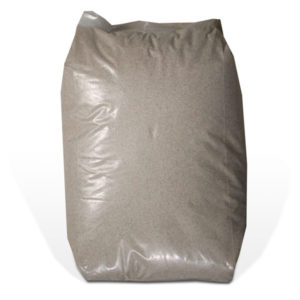About the media
Deironing and softening media "Multisorb" is a multi-functional water filter media consisting of several different filtration medias. Multisorb removes water hardness (calx), iron, manganese and organic matter (yellowish water color) by ion exchange and by oxidation and adsorption processes, that help to ensure the highest level of filtration.
Operating principle
Water softening is carried out by ion exchange process, in which calcium and magnesium ions (which create the hardness of the water) are removed from the incoming water. During this process, the hard water passes through the resin layer of the water softener and deironer. Here, calcium and magnesium ions are replaced by sodium or potassium ions to make the water softer. As the water passes through the Multisorb clarifying and softening media, the hardness ions stick to the media and are replaced by sodium or potassium ions. As a result, the softened water no longer leaves white marks of limestones! Catalytic absorbers oxidise soluble iron and manganese into insoluble forms which are then filtered out of the water. In addition, specialised absorbents in the medium absorb organic compounds, thus improving the overall quality of the water (often removing the yellowish colour). Over time, the filter media becomes saturated with the substances listed above and needs to be regenerated with a concentrated salt solution. The solution helps to release the accumulated substances from the water filter media during regeneration process. All the collected substances are removed to the sewer. This method ensures a continuous supply of soft and iron-free water, reducing the common problems associated with hard, iron-rich water in both residential and industrial premises.
Use
During regeneration process, the resin layer expands by 50-70 % of its volume for at least 10-15 minutes. During this time, the media is backwashed to ensure better absorption of the salt solution during the next operation. Therefore, the relationship between the volume of the media and size ofwater filter column into which the filler is to be added is of crucial. It is beause the Multisorb deironing and softening media must have room to expand in the column during the backwash. The correct ratio of media volume to filter column size will ensure a reliable and long service life. Then comes the most important part operation - Salt pulling. The concentrated salt solution is dripped onto the media. As the solution flows through the media, it 'releases' the calcium, magnesium, iron, manganese and organic impurities that have accumulated in the filter media and removes them into the sewer. During the remaining operations, the aggregate is being prepared to be fully fucntional again. Its worth mentioning that no trace of salt is left in the media. It is also important to note that salt does not enter the system and there is no chance of feeling any trace of it. During the regeneration process, American filters supply water by opening the inner bypass line (Chinese filters often completely shut off the water and leave no water in the house) to prevent salt from entering the system.
Benefits
Water deironing and softening media has many advantages. For example, pipes and appliances do not accumulate limescale and iron deposits, which can prolong their service life and increase efficiency (electric boilers). Softened water reduces the amount of soap and washing detergents needed, making dishes, laundry and skin cleaner and saving on the cost of these products. It is worth noting that if the water has an unpleasant colour, it is also removed. The biggest advantage is that there is no need for separate filtration systems (iron removal + softener), which is expensive. Last but not least, there is only one filter. It saves space (one column is enough instead of the usual three), which is very important in today's compact houses, and in the event of a failure, one filter instead of three has to be dealt with, which reduces future costs in the event of a filter failure.
Drawbacks
The biggest disadvantage of this media is that it does not remove the hydrogen sulphide (rotten egg) smell that classick water deironer does (but deironers do not soften the water). Therefore, in the event of an unpleasant smell, a separate filter would need to be built. housing with a cartridge against bad smell. Further, the ion exchange process saturates the water with sodium, so that if the amount of lime removed from the water is very high (~13mg-eq/litre or more), the sodium concentration can rise above the limit of the hygiene standards. Such water is not recommended for drinking. However, this is a disadvantage of all softening medias and is not a particular disadvantage of this particular filter media. Another point is maintenance. For a water softener to work properly, it will need regular maintenance to fill salt into the tank. Its consumption will depend on the actual quantities of water used and the lime level in the water. For example, one package of 25kg of salt is roughly sufficient for 25m3 of water (with a total hardness of 10mg-eq/litre in the influent water). If the water has a total hardness of 6mg-eq/litre, then a pack of salt will last longer, for up to 35m3. That salt consumption depends on the amount of water consumed, it can be said that if less water is consumed, less salt needs to be added. And vice versa, more salt will be used if more water is being consumed. Despite these drawbacks, many consider that the benefits of reduced maintenance and improved water quality outweigh these potential disadvantages.





Reviews
There are no reviews yet.